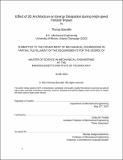Effect of 3D Architecture on Energy Dissipation during High-speed Particle Impact
Author(s)
Butruille, Thomas
DownloadThesis PDF (1.448Mb)
Advisor
Portela, Carlos M.
Terms of use
Metadata
Show full item recordAbstract
Ultralight mechanical metamaterials enabled by additive manufacturing (AM) have previously achieved density-normalized strength and stiffness properties that are inaccessible to monolithic materials, but the majority of this work has focused on static loading while the mechanical properties of these metamaterials under extreme dynamic loading conditions has remained largely unexplored. Here, using supersonic microparticle impact, the impact response of different 3D-printed microscale architectures are compared to each other and a non-architected mass equivalent sample to examine the effect of architecture on material impact response. This response is analyzed in a mass-normalized context and a dimensionless context analogous to (spatially confined) planetary impact. Ultra high-speed imaging and post-impact scanning electron microscopy reveal qualitative differences in the energy dissipation mechanisms present between impacts on architected and bulk materials. Additional uniaxial compression experiments on equivalent architected samples help separate the energy dissipation components during impact. This investigation could lead to improvements in the design process of lightweight materials for energy mitigation applications such as armor and protective coatings.
Date issued
2023-06Department
Massachusetts Institute of Technology. Department of Mechanical EngineeringPublisher
Massachusetts Institute of Technology